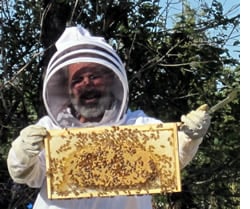 Some CM.com members may have become interested in beekeeping as one possible means of increasing resilience in their lives. In this What Should I Do (WSID) article, Small-Scale Beekeeping, user apismellifera gives a great introduction to the topic (the pictures are of Langstroth equipment; you may want to remember this for later in this article). In this article, we'll be getting a lot more specific about a particular task unique to winter beekeeping.
Some CM.com members may have become interested in beekeeping as one possible means of increasing resilience in their lives. In this What Should I Do (WSID) article, Small-Scale Beekeeping, user apismellifera gives a great introduction to the topic (the pictures are of Langstroth equipment; you may want to remember this for later in this article). In this article, we'll be getting a lot more specific about a particular task unique to winter beekeeping.
Beekeepers would, ideally, like to be able to winter our bees without supplemental feeding. Bees, after all, have been getting through winter far longer than humans have been managing bees. Bees, planning ahead, store honey and pollen specifically for this purpose. These days, with winter losses frequently hitting 30-40% of colonies dying each year, many of us are turning to feeding as a way of increasing our chances of getting to spring with live bees. Where Old Man Winter can keep temperatures down in the 20s (F) or below for extended periods of time, it's nice to have a way to get supplemental feeding to your bees without dealing with liquid syrup feeders. Liquid feeders, especially in cold temperatures, can potentially do harm by chilling your bees, which is clearly not what you set out to do when you decided to feed them.
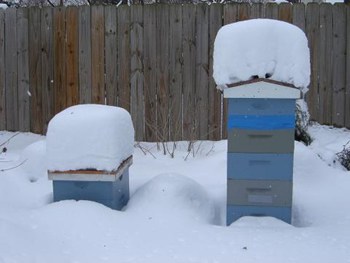 Keeping bees in the Denver metropolitan area calls for 70 to 90 pounds of honey and pollen per colony to get through winter. In this case, we are defining winter as the time from the beginning of October to the beginning of April. I make sure that my harvest, if any, leaves adequate stores of natural food for my girls. However, I have had the unfortunate experience of opening a colony in spring to find all the girls head down, butts in the air, dead. This was despite the fact that there were adequate stores of honey in the next frame over. This experience has sensitized me to want an insurance policy. I call this insurance “bee candy.”
Keeping bees in the Denver metropolitan area calls for 70 to 90 pounds of honey and pollen per colony to get through winter. In this case, we are defining winter as the time from the beginning of October to the beginning of April. I make sure that my harvest, if any, leaves adequate stores of natural food for my girls. However, I have had the unfortunate experience of opening a colony in spring to find all the girls head down, butts in the air, dead. This was despite the fact that there were adequate stores of honey in the next frame over. This experience has sensitized me to want an insurance policy. I call this insurance “bee candy.”
I've tried syrup feeding in the fall, but found that to be too labor intensive, standing by the stove nearly every night to ensure all the feeder jars are topped off early the next day. I found that this ritual had to be repeated for several weeks to get adequate stores prepared. I also didn't like this solution because I was always vulnerable to a mason jar full of syrup freezing and breaking, giving me a mess and leaving the bees high and dry.
“Bee candy” is a nice dry solution that I can use in the coldest part of winter. I hope the bees won't need it, but it feels good introducing that bit of insurance that helps me sleep better. I originally got the idea of hard candy for bees from Mel Disselkoen's website www.mdasplitter.com. Then, not knowing what I was doing, I got my first candy cooking lesson from my friend and local beekeeper, Denise O'Connor. Since that time, I've become bold and modified the recipe to the point that I'm very pleased with it. I'm hoping you will find it beneficial too.
Note: One pound of sugar is about equal to 2 cups of sugar. So, for this recipe, I found it convenient to use a 4 pound bag of sugar. First batch you must scoop out the 4 cups (2 pounds); next batch you can just dump in the remainder of the bag.
Recipe and Advice:
- 4 cups pure cane sugar (don't use GMO from beets and such)
- 1 cup water
- 1/4 teaspoon vinegar
-
1/4 cup glucose (this keeps the candy a little soft). I find my glucose at Hobby Lobby in the cake decoration section; a one-cup container (look for purple label) makes four batches.
Note: Do not use high fructose corn syrup (HFCS) as a glucose substitute. When heated, HFCS creates the compound hydroxymethylfurfural (HMF). HMF is toxic to bees. It does not take much heat, as a dramatic increase in HMF occurs at 120°F. - 1/2 cup MegaBee for protein
Options: As a water substitute, you can make chamomile tea (two tea bags) with 1 teaspoon "Honey B Healthy" and 1/2 teaspoon of natural sea salt with minerals (typically not pure white in color) per quart. Using this water substitute will cause the candy to bubble up a bit more than it otherwise would. Just turn the heat down a bit until the bubble-up stops (this happens as the liquid starts to look clear) and then turn the heat back up.
Tools you need:
- 4-quart pan
- Whisk
- Butter knife
- Spoon
- Spatula
- Measuring spoons
- Measuring cups
- Hot pads
- Wax paper
- Candy thermometer
Steps:
- Boil sugar, water, vinegar, and glucose to 234°F (soft ball), stirring with a whisk.
- Remove from heat and QUICKLY whisk in 1/2 cup MegaBee (powder), which turns the candy brown. At this point, your candy is starting to harden, and if you dilly dally, it will be too hard to spread before you know it. You have less than one minute. Try to get the MegaBee mixed in 15 seconds if you can.
- Spread on wax paper using a form if you wish. See the pictures.
Warning: The following 2 paragraphs contain a lot of vocabulary that may be unfamiliar to folks not keeping bees. I have chosen not to define all these terms in this article. Still, I think you will get the idea if you spend some time looking at the pictures.
In the case of a Langstroth hive, I put the candy brick directly onto the queen excluder, which is directly above the brood area. I have a special little “super” that will essentially fit the candy brick with some bee space around the candy. The inner cover goes directly on top of this little super, and the telescoping cover goes over that as usual. (See picture.) This works out really nice because the heat and moisture from the cluster rises and hits the hard candy, making it just a little bit softer and just right for a bee to take a bite.
In the case of a top-bar hive (TBH), I put the candy brick in the hive opposite the brood nest end. I have to break the candy brick in half to get it to fit. In my TBH, the brood nest is at one end, near the front door. Then there's all the honey expanding toward the other end. I've saved some room at the far other end using a divider board in the TBH. When winter candy time comes around, I move the divider board closer to the opposite end, giving me some space for the candy brick. Break it in half and put it in there. They will find it if they need it. Special thanks to Marci Heiser for providing the photo of the top-bar hive.
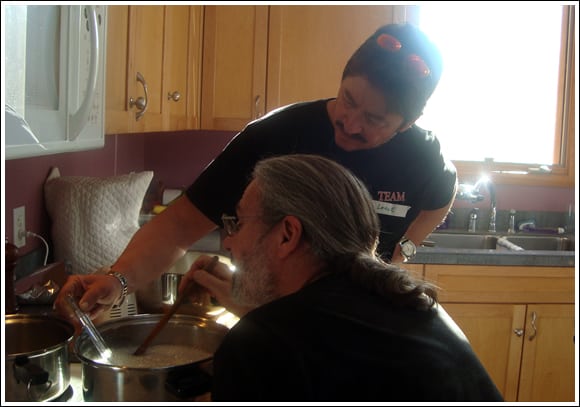
This first picture shows me watching the candy thermometer. I noticed that it rises, then pauses, then rises rapidly to the desired temperature. Don't let that pause fake you into looking away. You have to hit 234°F exactly.
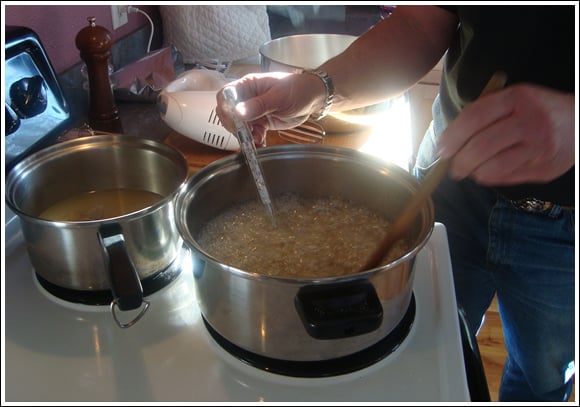
Here's what the candy looks like boiling. Notice the bee tea on the back burner.
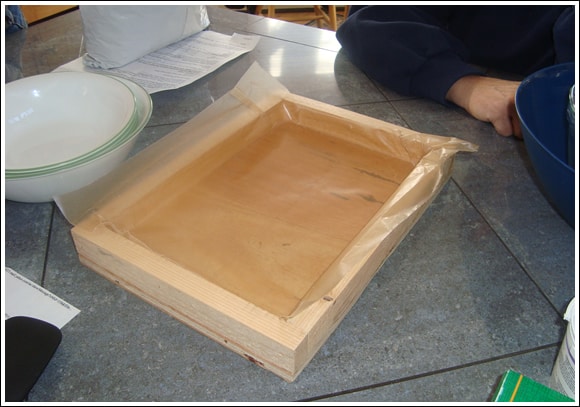
Here's my form with wax paper ready to receive the hot candy. It forms a brick about 10.5” x 7” x 1”. Heads up: If you let it get too hard in the form, then it can be quite difficult to get out. If you pull it out while it is still a little warm and soft, then it comes out very easily. Special thanks to David Braden for designing and making these forms for me.
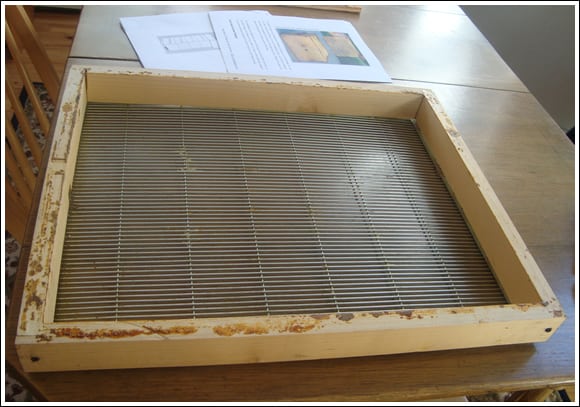
Here's my “little super” sitting on a queen excluder as an illustration of how to load the candy for my fellow beekeepers. Special thanks to David Braden for designing and making these supers for me.
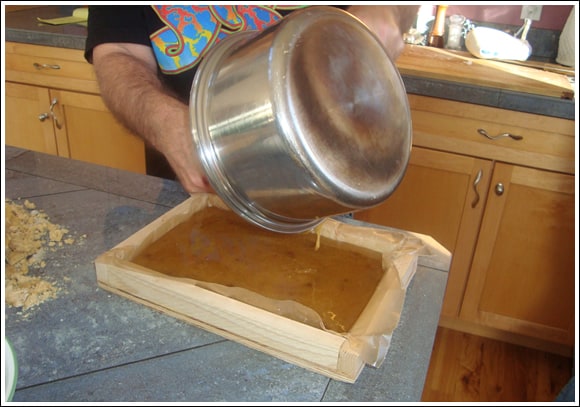
Here's a shot of loading the form with candy. Notice the candy is brown from the MegaBee. Also notice that the form doesn't quite fill up. I usually make 2 bricks for a Langstroth hive and one brick for a top-bar hive.
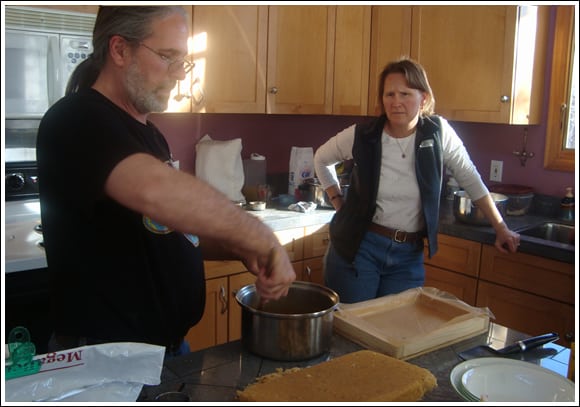
In this shot you can see a brick cooling in the foreground. It gives you a sense of the dimensions of a completed brick.
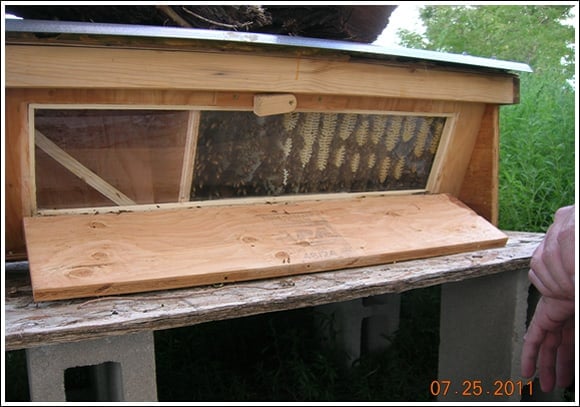
Here's a picture of a top-bar with space saved to the left for candy when the time comes for Winter feeding. The brood nest is to the far right.
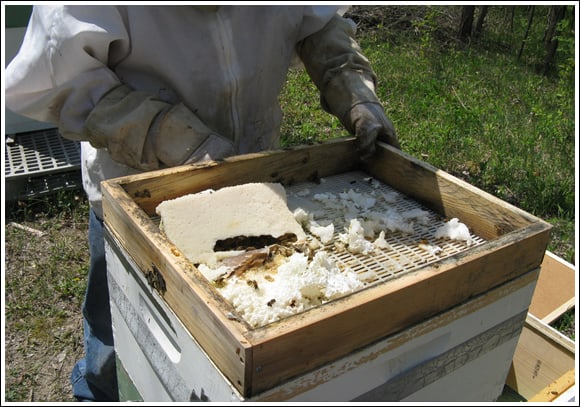
This is a picture of Mel opening up a hive in spring that has been fed bee candy. Mel's candy doesn't look exactly like mine (it's white), however, this gives you a good idea of what you want to see after the girls have been feeding on the candy.
Don Studinski is a long time PeakProsperity.com member and supporter of the Martenson Brigade. He is keeping bees in the Denver Metropolitan area, currently in Broomfield and Golden, but expanding all the time. His focus is on expanding the bee population; more so than producing honey.
This is a companion discussion topic for the original entry at https://peakprosperity.com/honey-bee-candy-winter-feeding-2/
 They up and run away from home every couple of years . They are close around and come back to polinate the trees/garden but I miss the honey .
They up and run away from home every couple of years . They are close around and come back to polinate the trees/garden but I miss the honey .